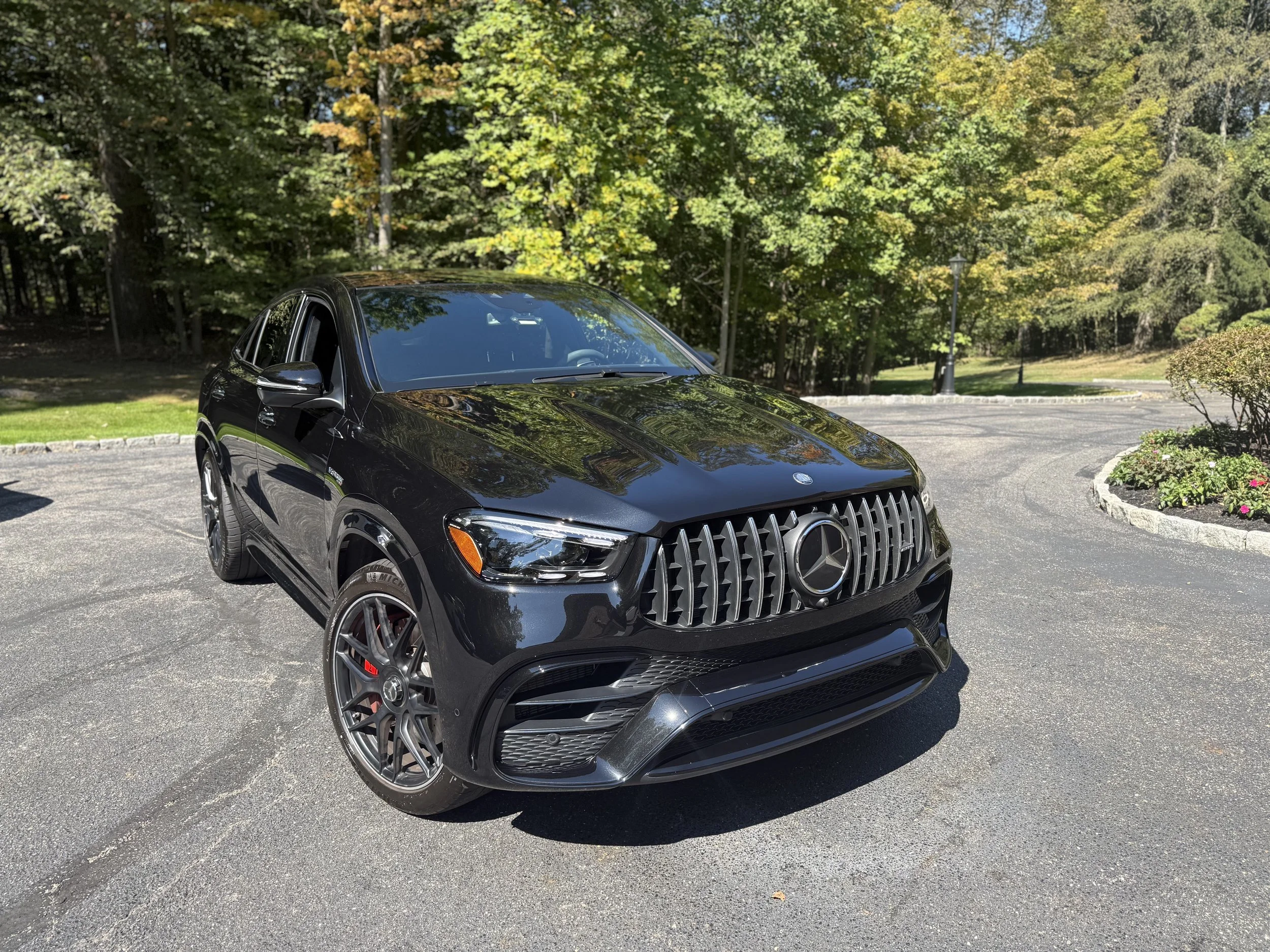Ceramic Coatings
Overview
Ceramic coatings are liquid polymer products applied to the exterior surfaces of vehicles to provide a protective layer. Made primarily from silica or silicon dioxide (SiO₂), ceramic coatings form a chemical bond with the paint, creating a hard, glass-like barrier. When cured, this barrier enhances the car’s durability and resistance to various environmental factors, such as:
• Protection from UV rays: Prevents oxidation and fading of paint.
• Hydrophobic properties: Water and contaminants bead off easily.
• Chemical resistance: Protects against acidic substances like bird droppings or road salts.
• Enhanced gloss: Gives the vehicle a shiny, polished look.
• Scratch resistance: Provides a harder surface, though it’s not entirely scratch-proof.
Ceramic coatings typically last longer than traditional wax or sealants, making them a popular option for car owners looking for long-term protection. They can also be applied to other surfaces like glass, plastic, and wheels.
Available Options
We offer a wide range of options that meets your needs.
Options: 5 Year, 4 Year, 3 Year, 2 Year, 1 Year,
What’s Included?
Deep clean hand wash
Fallout remover
Claybar
Tire dressing
Brake dust removal
Paint correction of your choice
Prep for coating
Ceramic coating of your choice
5. Maintenance Required: Though easier to maintain than waxes, ceramic coatings still need regular washing to remove contaminants. Failing to maintain the coating can lead to degradation or diminished performance over time.
6. Limited Lifespan: Despite being long-lasting compared to traditional waxes or sealants, ceramic coatings do not last forever. Depending on the product, they typically last between two to five years before needing reapplication.
7. No Protection Against All Hazards: While they resist many contaminants, ceramic coatings don’t protect against everything. Tar, brake dust, or industrial fallout may still require special attention for removal.
Overall, ceramic coatings are highly effective but require a significant upfront investment and ongoing maintenance.
Pros
Ceramic coatings offer a range of benefits, particularly for vehicle protection and appearance. Here are the key pros:
1. Long-Lasting Protection: Ceramic coatings can last for years, much longer than traditional wax or sealants. High-quality coatings can last anywhere from 2 to 5 years or more, depending on the product and care.
2. Enhanced Gloss and Shine: Ceramic coatings provide a deep, glossy finish that enhances the vehicle’s paint, making it look newer and more vibrant. The reflective properties help the car stand out visually.
3. Hydrophobic Properties: One of the biggest advantages is the strong hydrophobic effect. Water, dirt, and grime bead off easily, making it easier to clean the car and reducing water spots.
4. UV and Oxidation Resistance: The coating helps protect the paint from harmful UV rays, which can cause oxidation and fading over time, especially on vehicles exposed to sunlight frequently.
5. Chemical Resistance: Ceramic coatings protect the vehicle’s paint from acidic substances like bird droppings, tree sap, and road salt, which can cause long-term damage if left untreated.
6. Minor Scratch Resistance: While not completely scratch-proof, ceramic coatings create a harder surface that can resist light scratches and swirl marks better than uncoated paint.
7. Easier Maintenance: With the smooth, glass-like surface of a ceramic coating, dirt and grime don’t stick as easily. This means less frequent and easier cleaning, as contaminants can be wiped off more effortlessly.
8. Protection Against Environmental Contaminants: The coating acts as a shield against pollutants like dust, road tar, industrial fallout, and other contaminants, helping to keep the car looking cleaner for longer.
9. Cost-Effective Over Time: Though the initial cost is higher than waxing, ceramic coatings reduce the need for frequent reapplication of wax or sealants, saving time and money in the long run.
10. Preserves Paintwork: By forming a durable protective layer, ceramic coatings help preserve the factory paint and keep the car looking new for a longer period.
Overall, ceramic coatings provide superior protection and aesthetic benefits, making them a popular choice for car enthusiasts seeking long-term solutions.
Cons
While ceramic coatings offer numerous benefits, there are also some drawbacks to consider:
1. Cost: Professional ceramic coatings can be quite expensive, especially if applied by a detailing expert. Prices can range from hundreds to thousands of dollars, depending on the quality and duration of the protection.
2. Complex Application Process: DIY application kits are available, but achieving professional-level results can be challenging without experience. Improper application may result in streaks, high spots, or uneven surfaces, requiring correction.
3. Labor-Intensive Prep Work: The vehicle’s paint must be meticulously cleaned, polished, and sometimes corrected before applying the ceramic coating. Any imperfections will be sealed in, making preparation crucial.
4. Not Scratch-Proof: While ceramic coatings provide some scratch resistance, they are not invincible. Deep scratches, rock chips, or abrasive contact can still damage the coating and the underlying paint.
3 Year Coating
Choose Your Plan
$1349.99*
*SEDANS STARTING AT
5-Year Ceramic Coating Package
Protect Your Vehicle for Years
Our 5-Year Ceramic Coating Package delivers long-lasting paint protection, enhanced gloss, and easier maintenance. Every vehicle receives a professional exterior prep and polishing to ensure the coating bonds perfectly and delivers maximum durability.
Key Features:
✅ 5-Year Ceramic Paint Coating for long-lasting shine and protection
✅ Full exterior prep and polish for flawless results
✅ Professional application by trained technicians
✅ Includes 1-Step Paint Correction
Ideal For: Car owners who want long-term protection, high gloss, and reduced maintenance without interior or underbody services.
Service Time: Approximately 2–3 days
Optional Add-Ons: Wheels-off barrel coating, interior protection, pre-paid maintenance packages
Expected Durability: Up to 5 years or approx. 10,000 miles per year. Winter conditions will alter expected results.
BEST VALUE
$2279.99
*SEDANS STARTING AT
🌟 Grayson’s Ultimate Package – 5-Year Ceramic Coating
(Premium Full-Vehicle Protection – Approx. 4-6 Day Service) We take pride in our work and ensure every detail is perfect.
Why It’s Our Top Package
Give your vehicle showroom gloss and long-term defense in a single visit. This all-inclusive service layers every critical surface—paint, interior, glass, and underbody—with professional-grade protection.
What’s Included:
✅ 5-Year Ceramic Coating – unmatched paint shine & hydrophobic protection
✅ Full Exterior Prep & Polish – deep decontamination and machine polish
✅ Deluxe Interior Detail – steam cleaning, leather/fabric shampoo & protectant
✅ Underbody Wash + Fluid Film Treatment – rust prevention inside panels & seams
✅ Glass & Leather Coatings – added clarity and stain resistance
✅ Wheel Faces coated for easy cleaning
Perfect For
Owners keeping their vehicle 3–5+ years who want maximum resale value and a “just detailed” look every day.
Why Choose This Package Over Others:
Complete protection inside and out — not just paint
Includes premium add-ons like underbody and wheel-barrel coating
Ideal for owners who want a “showroom finish” for years
Perfect for long-term vehicle value and daily pride of ownership
Expected Durability: Up to 5 years or aprox. 10,000 miles per year. Winter conditions will alter expected results.
Why “Grayson’s Ultimate Package”?
This package is named after a dream—my vision for creating something truly lasting and meaningful. Just like the care and dedication behind this service, the name represents the ultimate in protection, detail, and love for what matters most.
(Deposit required to secure appointment [20%] – clearly displayed at checkout)
$1269.99
*SEDANS STARTING AT
4-Year Ceramic Coating Package
Protect Your Vehicle for Years
Our 4-Year Ceramic Coating Package delivers long-lasting paint protection, enhanced gloss, and easier maintenance. Every vehicle receives a professional exterior prep and polishing to ensure the coating bonds perfectly and delivers maximum durability.
Key Features:
✅ 4-Year Ceramic Paint Coating for long-lasting shine and protection
✅ Full exterior prep and polish for flawless results
✅ Professional application by trained technicians
✅ Includes 1-Step Paint Correction
Ideal For: Car owners who want long-term protection, high gloss, and reduced maintenance without interior or underbody services.
Service Time: Approximately 2–3 days
Optional Add-Ons: Wheels-off barrel coating, interior protection, pre-paid maintenance packages
Expected Durability: Up to 4 years or approx. 10,000 miles per year. Winter conditions will alter expected results.






